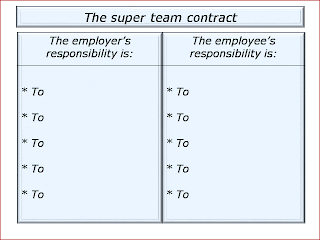3 tips for making a contract with your team

Imagine you are a team leader. One of your first jobs will be to make a clear working contract with the team. People must be clear on: a) The leader’s responsibilities; b) The team members’ responsibilities. The contract should cover both the psychological and practical responsibilities of working together. Here is one approach you can take to making such an agreement. Gather the team and invite them to focus on the following themes.
* You can clarify the leader’s responsibility in the team.
Invite people to brainstorm what they see as the leader’s role in ensuring the team reaches its goals. For example, to provide a clear vision; to manage upwards and provide ‘air cover’ - protecting them from interference; to create an encouraging environment; to give people practical support; to make clear contracts about each person’s contribution; to co-ordinate everybody’s strengths; to make tough decisions; to do what is necessary to guide the team to success. There will be a chance to discuss these ideas later - but first move onto the next stage.
* You can clarify the team members’ responsibility in the team.
Invite people to brainstorm what they see as the team members’ role in ensuring the team reaches its goals. For example, to choose to be in the team; to have a positive attitude; to understand the team’s vision; to make clear contracts about their best contribution; to encourage their colleagues; to be creative; to come with solutions, rather than problems; to deliver on their promises; to do whatever is necessary to help the team to achieve success. Again, there will be a chance to discuss these ideas later - but then move onto the next stage.
* You can clarify and agree on the team’s working contract.
Looking at the ideas under the respective responsibilities, invite people to arrange these under themes and discuss the topics. When you feel people are ready, invite the team members to agree to the team’s working contract. As the leader, you will have the final say, but team members often produce an excellent agreement. Conclude by writing-up the contract and, if appropriate, putting it in a place where people can see it each day.
How can you use the contract? There are two main ways. First, it provides a constant reminder of people’s respective responsibilities. Second, it can be used when tackling difficult situations. For example, if a person behaves badly, don’t get dragged down into arguing about the details. Just go back to the contract. Ask whether they want to follow or change the contract. Sometimes it may be appropriate to alter the conditions - but then make sure the whole team are in agreement. If a person continues to break the rules, however, they are choosing to leave the team. Clear contracting provides the basis for building a successful team.
Invite people to brainstorm what they see as the leader’s role in ensuring the team reaches its goals. For example, to provide a clear vision; to manage upwards and provide ‘air cover’ - protecting them from interference; to create an encouraging environment; to give people practical support; to make clear contracts about each person’s contribution; to co-ordinate everybody’s strengths; to make tough decisions; to do what is necessary to guide the team to success. There will be a chance to discuss these ideas later - but first move onto the next stage.
* You can clarify the team members’ responsibility in the team.
Invite people to brainstorm what they see as the team members’ role in ensuring the team reaches its goals. For example, to choose to be in the team; to have a positive attitude; to understand the team’s vision; to make clear contracts about their best contribution; to encourage their colleagues; to be creative; to come with solutions, rather than problems; to deliver on their promises; to do whatever is necessary to help the team to achieve success. Again, there will be a chance to discuss these ideas later - but then move onto the next stage.
* You can clarify and agree on the team’s working contract.
Looking at the ideas under the respective responsibilities, invite people to arrange these under themes and discuss the topics. When you feel people are ready, invite the team members to agree to the team’s working contract. As the leader, you will have the final say, but team members often produce an excellent agreement. Conclude by writing-up the contract and, if appropriate, putting it in a place where people can see it each day.
How can you use the contract? There are two main ways. First, it provides a constant reminder of people’s respective responsibilities. Second, it can be used when tackling difficult situations. For example, if a person behaves badly, don’t get dragged down into arguing about the details. Just go back to the contract. Ask whether they want to follow or change the contract. Sometimes it may be appropriate to alter the conditions - but then make sure the whole team are in agreement. If a person continues to break the rules, however, they are choosing to leave the team. Clear contracting provides the basis for building a successful team.
You can find many more exercises on teamwork in the free download The Super Teams Pack, that can be found at:
Labels: peak performance, strengths, super teams

0 Comments:
Post a Comment
Subscribe to Post Comments [Atom]
<< Home